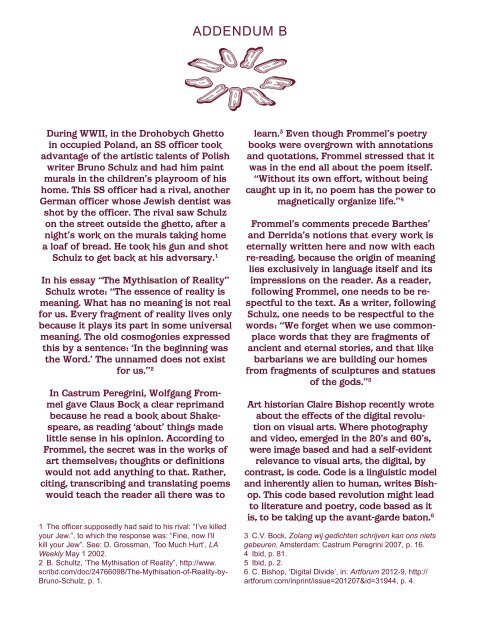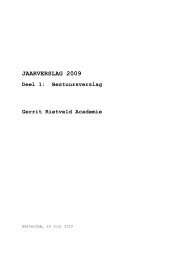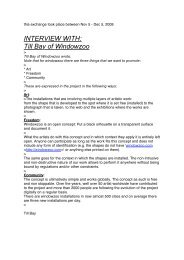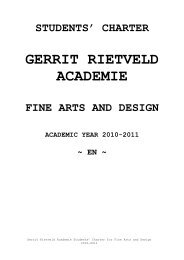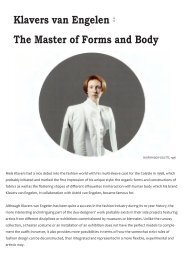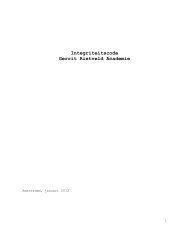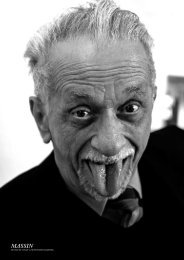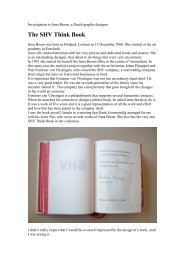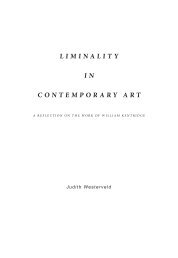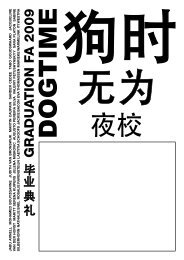ADDENDUM B - Gerrit Rietveld Academie
ADDENDUM B - Gerrit Rietveld Academie
ADDENDUM B - Gerrit Rietveld Academie
You also want an ePaper? Increase the reach of your titles
YUMPU automatically turns print PDFs into web optimized ePapers that Google loves.
<strong>ADDENDUM</strong> B<br />
During WWII, in the Drohobych Ghetto<br />
in occupied Poland, an SS officer took<br />
advantage of the artistic talents of Polish<br />
writer Bruno Schulz and had him paint<br />
murals in the children’s playroom of his<br />
home. This SS officer had a rival, another<br />
German officer whose Jewish dentist was<br />
shot by the officer. The rival saw Schulz<br />
on the street outside the ghetto, after a<br />
night’s work on the murals taking home<br />
a loaf of bread. He took his gun and shot<br />
Schulz to get back at his adversary. 1<br />
In his essay “The Mythisation of Reality”<br />
Schulz wrote: “The essence of reality is<br />
meaning. What has no meaning is not real<br />
for us. Every fragment of reality lives only<br />
because it plays its part in some universal<br />
meaning. The old cosmogonies expressed<br />
this by a sentence: ‘In the beginning was<br />
the Word.’ The unnamed does not exist<br />
for us.” 2<br />
In Castrum Peregrini, Wolfgang Frommel<br />
gave Claus Bock a clear reprimand<br />
because he read a book about Shakespeare,<br />
as reading ‘about’ things made<br />
little sense in his opinion. According to<br />
Frommel, the secret was in the works of<br />
art themselves; thoughts or definitions<br />
would not add anything to that. Rather,<br />
citing, transcribing and translating poems<br />
would teach the reader all there was to<br />
1 The officer supposedly had said to his rival: “I’ve killed<br />
your Jew.”, to which the response was: “Fine, now I’ll<br />
kill your Jew”. See: D. Grossman, ‘Too Much Hurt’, LA<br />
Weekly May 1 2002.<br />
2 B. Schultz, ‘The Mythisation of Reality”, http://www.<br />
scribd.com/doc/24766098/The-Mythisation-of-Reality-by-<br />
Bruno-Schulz, p. 1.<br />
learn. 3 Even though Frommel’s poetry<br />
books were overgrown with annotations<br />
and quotations, Frommel stressed that it<br />
was in the end all about the poem itself.<br />
“Without its own effort, without being<br />
caught up in it, no poem has the power to<br />
magnetically organize life.” 4<br />
Frommel’s comments precede Barthes’<br />
and Derrida’s notions that every work is<br />
eternally written here and now with each<br />
re-reading, because the origin of meaning<br />
lies exclusively in language itself and its<br />
impressions on the reader. As a reader,<br />
following Frommel, one needs to be respectful<br />
to the text. As a writer, following<br />
Schulz, one needs to be respectful to the<br />
words: “We forget when we use commonplace<br />
words that they are fragments of<br />
ancient and eternal stories, and that like<br />
barbarians we are building our homes<br />
from fragments of sculptures and statues<br />
of the gods.” 5<br />
Art historian Claire Bishop recently wrote<br />
about the effects of the digital revolution<br />
on visual arts. Where photography<br />
and video, emerged in the 20’s and 60’s,<br />
were image based and had a self-evident<br />
relevance to visual arts, the digital, by<br />
contrast, is code. Code is a linguistic model<br />
and inherently alien to human, writes Bishop.<br />
This code based revolution might lead<br />
to literature and poetry, code based as it<br />
is, to be taking up the avant-garde baton. 6<br />
3 C.V. Bock, Zolang wij gedichten schrijven kan ons niets<br />
gebeuren, Amsterdam: Castrum Peregrini 2007, p. 16.<br />
4 Ibid, p. 81.<br />
5 Ibid, p. 2.<br />
6 C. Bishop, ‘Digital Divide’, in: Artforum 2012-9, http://<br />
artforum.com/inprint/issue=201207&id=31944, p. 4.
One could argue whether code is inherently<br />
alien to human or even claim the<br />
exact opposite: is code not inherently human?<br />
Every code that can be recognized<br />
as such, is waiting to be decoded and understood.<br />
7 As Schulz wrote: “The human<br />
spirit is tireless in its glossing of life with<br />
the aid of myths, its ‘making sense’ of<br />
reality.” 8 The second question is whether<br />
images and objects, are truly so distinct<br />
from code. We seem to read gestures,<br />
clothing styles, branded consumer products,<br />
jpegs of art works, just as easily, or<br />
arduously, as we read words.<br />
Whether we are barbarians or poets,<br />
drawing from statues of gods or binary<br />
codes, words and signs exist because of<br />
their repetitive powers that cause them<br />
to be recognized. The unnamed—unregisterable<br />
and unprocessable as it is—might<br />
not exist to us, yet, in every new context,<br />
every new combination of signs, in a<br />
meeting with its receiver, a new meaning<br />
occurs. A new meaning waiting to be<br />
deciphered, read, written.<br />
How long would the murals Schulz<br />
painted have been visible to the family<br />
of Felix Landau? Did the family move out<br />
straight upon Soviet liberation of Poland,<br />
that later became Ukraine? Although<br />
the murals faded as Roman fresco’s,<br />
and eventually were painted and plastered<br />
over, people continued to live in<br />
the house in Drohobycz with the hidden<br />
paintings as an invisible décor.<br />
In 2001, a documentary filmmaker discovered<br />
the murals. 9 A team of experts<br />
started to remove the outer layers of<br />
paint from the walls, and found indeed<br />
traces of the murals. While in the Ukraine<br />
the restoration of the paintings was being<br />
planned, the five fragments suddenly<br />
disappeared. They were removed from<br />
the walls together with the plaster and<br />
transported to Israel, to the Yad Vashem<br />
Holocaust museum, after which a painful<br />
and lengthy quarrel broke out between<br />
Ukraine and Israel. The painting were<br />
almost divided in two, when a deal was<br />
struck whereby the murals belong to<br />
Ukraine but are on long-term loan to Yad<br />
Vashem. 10<br />
The murals Schulz painted represented<br />
scenes from Grimm’s fairy tales, stories<br />
in its own right. The Schulz murals, as an<br />
inverted backdrop, have had myriad of<br />
stories unfold in front of them and they<br />
too became many stories.<br />
A book becomes a reality, which becomes<br />
another book. And as long as this new<br />
book is read, or even invisible yet discoverable,<br />
the cycle will continue.<br />
Marieke Berghuis, October 2012<br />
7 In my thesis I made a reference to the documentary<br />
Into Eternity about the Finnish nuclear fuel repository,<br />
Onkalo. When building the repository, there was a debate<br />
whether the entrance of Onkalo should be marked<br />
with warning signs for future inhabitants of the region.<br />
Unlikely that in 100.000 years people would still be able<br />
to read the alphabet, different pictural warning signs were<br />
presented. In the end, it was decided to cover up the entrance<br />
as good as possible. The chance that discoverers<br />
of signs would search for meaning, for a hidden treasure,<br />
seemed more likely than that they would leave the signs.<br />
See M. Berghuis, Pharmakon: De magie van het schrift<br />
(graduation thesis <strong>Gerrit</strong> <strong>Rietveld</strong> <strong>Academie</strong>) 2012, p.<br />
11-12.<br />
8 B. Schultz, ‘The Mythisation of Reality”, p. 1.<br />
9 B. Geissler, Finding Pictures, 2003.<br />
10 E. Bronner, ‘Behind Fairy Tale Drawings, Walls Talk<br />
of Unspeakable Cruelty’, New York Times February 27<br />
2009.


